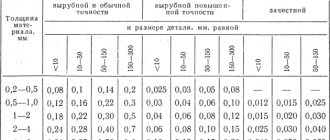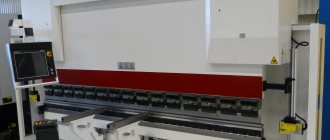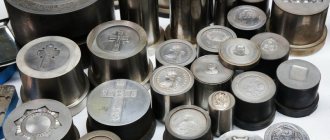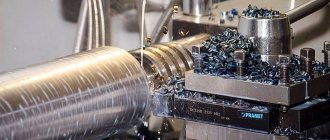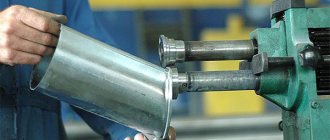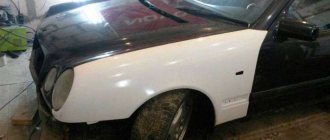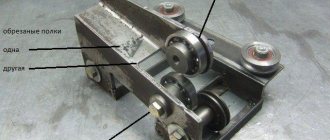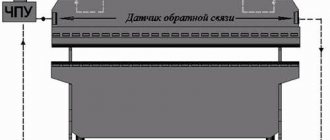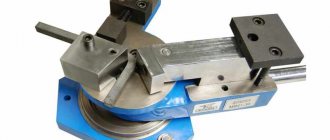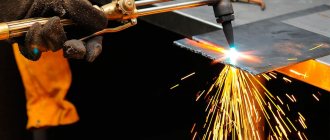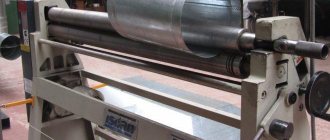Types of stamping - each part has its own technology
Stamping activities are divided into form-changing and disconnecting. Form-changing processes mean operations such as cold extrusion, drawing, and molding. Separating stamping is a procedure in which metal (usually sheet metal) is divided into specified geometric parts (chopping, cutting, punching).
The process we are considering for producing stamped parts can be volumetric or sheet.
The process of obtaining stamped parts
If parts are manufactured from metal sheets with a thickness of no more than 6 millimeters, we are talking about sheet stamping. In all other cases, they speak of a volumetric operation. Stamping is performed using special mechanisms called presses. They are capable of deforming the original workpiece through mechanical action.
Stamping of metal sheets is carried out according to different schemes depending on the equipment used to change the size and shape of the material. From this point of view, stamping occurs:
- roller;
- hydro- or magnetic-pulse;
- elastic media;
- explosion;
- in tool dies.
Metal sheet stamping
The production of stamped products is carried out using two technologies - cold and hot. Next, we will look at the most commonly used methods for producing a variety of parts by stamping.
Hot stamping for mass production of products
This process refers to the method of processing metal blanks by pressure. The raw material for the operation is rolled products - periodic, rectangular, square or round profiles. Before processing, it is cut into pieces of certain sizes. In some cases, the forging is separated from the rolled product directly on the stamping unit.
Pressure processing of metal blanks
A mandatory attribute of a hot volumetric operation is a stamp - a special tool with protrusions and cavities. When poured, the metal fills these “uneven spots.” At the final stage of stamping, a closed single cavity is formed according to the forging configuration. Stamps can be closed or open.
Volumetric hot stamping is recommended for mass and large-scale production of parts. This technology makes it possible to produce complex products (in shape). It is also characterized by the following advantages:
- excellent surface quality of the resulting parts;
- high productivity of the work process;
- impeccable precision of the shape of stamped parts;
- small amount of metal waste.
Volumetric hot stamping
Hot sheet stamping is used when metal products are made from sheets 3–4 millimeters in thickness. The initial workpiece is heated in special electric or flame furnaces.
Cold sheet stamping is a guarantee of high-precision parts
This operation has a number of advantages:
- the economic feasibility of using cold sheet metal stamping both in the production of products in small batches and when mass production of parts is carried out;
- the ability to produce products with high rigidity and strength with minimal weight;
- simplicity of automation and high-quality mechanization of stamping operations - one unit in 8–12 hours is capable of “producing” up to 35–40 thousand finished products;
- decent quality of the resulting surfaces and excellent accuracy of the parameters of the parts - finishing procedures are thereby reduced to a minimum;
- saving metal consumption;
- Possibility of producing small and large-sized parts.
Mass production of parts
For HLSH, workpieces made of brass, alloyed ductile metal alloys, titanium, magnesium and aluminum compositions, and low-carbon steels are used.
The source material is supplied to the stamping unit in the form of tapes and strips in rolls, sheets obtained by rolling.
Cold stamping is in demand for the production of products for the instrument and tractor industries, rocket, aircraft and automobile enterprises.
Volumetric stamping using “cold” technology is indispensable in the production of:
- helicopter elements – propeller bushings and other parts;
- crankshafts of internal combustion engines;
- supports (ball) of automobile suspensions;
- various hardware - toothed washers, oblique washers, and so on;
- any highly loaded and high-precision products.
Production of various hardware
Volumetric cold stamping makes it possible to obtain the specified parts without scratches and marks, as well as other surface defects.
Source: https://remoskop.ru/izgotovlenie-shtampovannyh-izdelij-metalla.html
Making artistic metal products
In the process of manufacturing decorative metal products
Various types of manual and mechanical processing can be used. Some of them have been known since ancient times, but have not lost their relevance today. This category mainly includes technologies for manual artistic processing of metals: engraving, difing, casting, filigree, etc.
They are labor intensive and low productivity. Manual processing requires a certain skill of a specialist. Using methods such as embossing, notching, etc., unique works of art are created. There are also innovative technologies for the manufacture of metal products, which are based on scientific discoveries and achievements in the field of technological development - electroplating, the latest types of casting, electrochemical processing, etc.
Choosing a technology for manufacturing a non-standard metal product
, the craftsman, in addition to economic efficiency, must take into account the features of different processing technologies - their impact on the process of forming the part itself and on the aesthetic component.
Depending on the chosen processing method, the finished product acquires certain features and characteristics. For example, parts processed on a machine for the manufacture of metal products
, are distinguished by dimensional accuracy, clarity of shape, and after forging or shaping, the products acquire softness and ductility.
Using cutting processing, you can obtain clear edges and sharp corners of parts. To ensure the correct radius bend line, stamping must be used.
Even at the stage of developing a design for artistic products, a specialist must take into account the characteristics of the material and, depending on this, determine the most suitable processing options.
Certain metal alloys can be processed in several ways. For example, gold and silver can be cast, forged, cut, and worked. At the same time, there are materials whose characteristics significantly narrow the list of acceptable processing options.
Thus, cast iron can be cast or cut, but its fragility is an obstacle to the use of technologies that use high pressure (forging, stamping, etc.). And copper alloys are easy to mint or forge, but are difficult to cut and cast.
Stamping of metal parts
DZPP LLC offers stamped sheet metal products manufactured in its own production. We use modern multifunctional machines that allow us to complete even the most voluminous and complex orders in a short time.
For stamping metal parts, we use FINN-POWER C5 CNC punching equipment. The machine has high-speed hydraulics F4, programmable stroke length, and the ability to select a punching mode. It develops a force of up to 30 tons, which allows you to work with sheets up to 3 mm thick.
From us you can order all types of stamping of metal parts, including according to individual drawings.
Availability of our own production base High technical level of production Maximum short lead times for orders Round-the-clock operation of production workshops
Advantages of stamping
High performance . Stamping allows you to quickly produce a large number of parts of the required shape, ready for use.
Accuracy . The resulting parts match in size and do not require additional adjustment or processing.
Versatility . Stamping makes it possible to produce parts of products of various sizes - from large-sized to filigree.
Features of the technology
Stamping is the processing of metal by pressure using a stamp. The latter consists of two elements – movable (punch) and fixed (matrix). In metal processing, cold sheet stamping is most often used. Based on the type of operations performed, it is divided into the following categories:
- dividing _ It involves separating one part of the workpiece from another. This group includes cutting, punching and cutting;
- formative . Allows you to obtain elements of complex configuration without destroying the original part. Form-forming operations include drawing, crimping, flanging, molding, and bending.
During the stamping process, the original workpiece experiences significant deformations. Therefore, this processing method can only be used for metals with good ductility. These include:
- aluminum and its alloys;
- low-carbon and ductile steel grades;
- brass with a copper content of more than 60%.
During stamping, the material is strengthened and its ductility is reduced. Since the workpiece does not heat up, the resulting part has a more dense structure and is less susceptible to deformation during subsequent processing.
On our website you can order stamping and provide a preliminary calculation of the cost of services. For more information, call us at our contact number.
Source: https://dzppm.ru/uslugi/cold-shtampovka/detaley-iz-metalla
Technology for manufacturing metal products
Before releasing finished products, manufacturers of metal products must carry out a number of technological operations that are necessary to give them certain characteristics.
The metallurgical industry supplies raw materials (rolled metal) in the form of various semi-finished products to metalworking enterprises. In this case, brittle alloys (cast iron and bronze) are supplied in massive ingots, while other materials can be supplied in rods, sheets or blanks of different sizes.
After mechanical processing of rolled metal, the necessary products and structures are obtained. In order for the finished product to meet the required standards and GOSTs, all technological operations must take place in accordance with certain requirements. Violation of technology often leads to the appearance of product defects (explicit or hidden).
Sheet stamping
- Sheet stamping
is a type of cold forming in which sheet material is deformed in a cold or heated state. - Sheet stamping produces a variety of flat and spatial parts - from small ones, weighing from fractions of a gram and measuring fractions of a millimeter (seconds hand of a watch), to medium-sized (metal utensils, lids, brackets) and large (facing parts of cars).
- The thickness of the workpiece during sheet stamping is usually no more than 10 mm, but sometimes it can exceed 20 mm; in this case, stamping is carried out with preheating to forging temperatures.
- When sheet stamping is used: low-carbon steels, ductile alloy steels, non-ferrous metals and alloys based on them, precious metals, as well as non-metallic materials: organic glass, felt, celluloid, textolite, felt, etc.
- Sheet stamping is widely used in various industries, especially in the automotive industry, rocketry, aircraft manufacturing, instrument making, and the electrical industry.
- The main advantages of sheet stamping:
- the ability to produce durable, lightweight and rigid thin-walled parts of simple and complex shapes, which are impossible or difficult to obtain by other methods;
- high dimensional accuracy and surface quality, allowing to reduce machining to a minimum;
- comparative simplicity of mechanization and automation of stamping processes, ensuring high productivity (30,000...40,000 parts per shift from one machine);
- good adaptability to the scale of production, in which sheet stamping can be economically beneficial in both mass and small-scale production.
Cold sheet stamping consists of performing separation and form-changing operations in a certain sequence, through which the original blanks are given the shape and dimensions of the part.
Sheet stamping operation
is the process of plastic deformation that provides a characteristic change in the shape of a certain section of the workpiece.
There are dividing
operations in which the stage of plastic deformation necessarily ends in destruction, and
forming
operations in which the workpiece should not be destroyed during the deformation process.
When designing a technological process for manufacturing parts by sheet stamping, the main task is to select the most rational operations and the sequence of their use, which makes it possible to obtain parts with specified performance properties at minimal cost and good working conditions.
All operations are performed using special tools - stamps, which have different designs depending on their purpose. Dies consist of working elements - a matrix and a punch, and auxiliary parts - clamps, guides, stops, etc. The punch is pressed into or enclosed by the deformable metal, and the die encloses the shape-changing workpiece and the punch.
Sheet forming operations
Separation operations
are intended either for obtaining a workpiece from a sheet or tape, or for separating one part of the workpiece from another. Operations can be performed along a closed or open loop.
The separation of one part of the workpiece from another is carried out by a relative displacement of these parts in a direction perpendicular to the plane of the workpiece. This displacement is initially characterized by plastic deformation and ends with destruction.
Segment
– separation of part of the workpiece along an open contour using special machines – scissors or stamps.
It is usually used as a procurement operation for dividing sheets into strips and blanks of the required size.
The main types of scissors are shown in Fig. 15.5.
Rice. 15.5. Schemes of operation of scissors: a – guillotine; b – disk
Scissors with translational movement of the cutting edges of the knife can be with parallel knives, for cutting narrow strips, with one inclined knife - guillotine (Fig. 15.5.a).
The cutting edges in guillotine shears are inclined to each other at an angle of 1...50 to reduce the cutting force. The sheet is fed until it stops, which determines the width of the cut strip B
.
The length of the cut strip L should not exceed the length of the knives.
Cold stamping of sheet metal: essence and purpose
This is the most popular method for producing a wide range of products made of polymers and metals, so it deserves detailed consideration. First of all, it captivates with its versatility - you can produce parts of any size and geometry, from miniature elements of household appliances to large aircraft housings. But there are other undeniable advantages.
Practical advantages of the method:
- High utilization of base material – no scraps or residues remain, reducing overall costs.
- The ability to produce elements even with thin walls without reducing their final strength.
- Low cost, especially convenient in conditions of serial and large-scale production.
- There is no need for finishing treatment - the surface of the product, as a rule, is quite smooth.
- Prospects in the matter of automation - the stamping process can be mechanized and improved in every possible way.
There is also a conditional disadvantage, which logically follows from the manufacturability of the operation and the high quality of the result. The disadvantage is that setup requires specialists with experience and good qualifications. Also, do not forget about the time spent on design - this is a rather labor-intensive part of the task. Although, of course, there are more advantages, and the advantages continue to determine the purpose of the method, which boils down to remaining the most productive and convenient option for processing workpieces under pressure.
Cold stamping operations
The actions taken are either divisive or form-changing. Therefore, the main procedures are as follows:
- Cutting – cutting of the base material, can be carried out either in a straight line or along a more complex trajectory. It is performed using industrial guillotines and/or large scissors, both at the starting and finishing stages of the production cycle.
- Punching is the creation of technological holes of the required (arbitrary) diameter and even shape.
- Cutting is another cutting, but it is already carried out in a closed loop, with the separation of the required part, which becomes the workpiece (herein lies the fundamental difference from the previous operation, in which the cut was considered waste).
- Drawing is a change in the volume of a part (a flat part is made hollow, and the wall thickness can also become different, usually thinner).
- Beading - creating a raised edge around the perimeter, internal or external. The most common applications are flange mounting locations and pipe ends.
- Bending is the transformation of a flat configuration into a curved one, usually U or V-shaped, but other options are possible, up to quite complex ones.
- Crimping - the element is fixed in a conical matrix and pressure is applied to its end part, reducing its size.
- Forming is a change in geometry in some local area of the workpiece (while its outer contour retains its dimensions).
Stamping of metal parts in Moscow
Modern progress does not stand still and every year both new and existing techniques for processing various materials appear and are modernized.
Stamping of metal parts is not a new operation, the quality and accuracy of which directly depends on the equipment and devices used.
It is innovative methods and modern machines that are the basis for high-quality and prompt execution of orders of any complexity.
JSC ELTEZA offers professional production of stamped metal parts. High-tech equipment and production facilities of our enterprise provide the ability to promptly fulfill orders of any complexity.
We will always be happy to ensure that work can be completed quickly and that we guarantee the quality of every part produced.
Modern sheet stamping is one of the advanced methods for producing various parts from sheet metal, which allows you to obtain the required result as quickly as possible and at minimal cost.
Technology for the production of stamped parts
Metal stamping involves a set of technological stages, the result of which is the required part. A very important parameter in this case is the consistency of equipment operation and the most accurate control of parameters when performing each process. Stamping of parts can be represented in the form of the following operations:
- metal cutting to ensure the optimal size of each workpiece;
- metal bending allows you to change the shape of the workpiece in the radial area;
- the forming process is designed to provide the desired shape while maintaining the basic contours of the part;
- crimping involves the use of dies designed to narrow individual parts of the workpiece;
- drawing the part is a mandatory element to achieve the maximum flatness of the product;
- flanging parts involves pressing the metal in a circle, expanding its diameter. This process is especially important in the manufacture of clamps, bends and flanges.
Thus, we can safely say that sheet metal stamping of parts is a complex, diverse process that may require a large number of different equipment and highly qualified personnel.
Note: manufacturing parts using this technology requires the design and manufacture of special technological equipment for production
Advantages of manufacturing parts by stamping
Modern stamping of sheet metal parts has many advantages over similar methods of processing materials. These include:
- the ability to process materials and manufacture parts of minimal weight, with increased requirements for the level of rigidity;
- the ability to obtain a part of maximum accuracy;
- all processes are performed on automated equipment, which eliminates the possibility of error due to the human factor;
- the ability to ensure high productivity and the customer receiving large quantities of goods in the shortest possible time.
These advantages make the production of parts using stamping one of the most profitable and affordable solutions for any enterprise.
Professional stamping services for parts in Moscow
JSC ELTEZA offers to order metal stamping on the most favorable commercial terms.
We are always ready to accurately reproduce the requirements of each customer and guarantee the quality of execution of any part, regardless of the complexity and size of the batch.
Our stamping of sheet metal parts in Moscow is in demand among both large companies and small organizations, and the prices we offer are among the most affordable in the region.
Source: https://www.loetz.ru/shtampovka-detaley
Punching technology
The technology for manufacturing parts by stamping, both hot and cold, requires the presence of tooling. For both types, stamps are made, which have certain differences. They are used for metal that has varying degrees of thickness.
Large sized workpieces are preheated and then the forging process takes place. When cold, the sheet thickness rarely exceeds 1 mm. Various operations are carried out with such material, for example, stamping badges.
Stamping technology
Cold stamping
During the cold stamping process of sheet metal, no heating is applied. The force of the press is enough to carry out separation or shaping operations. As a result, the resulting part is not subject to the shrinkage process. To save material, stamping is carried out according to the rules for cutting sheets, which are regulated by GOST.
Cold stamping includes the following operations:
- Punching. During the cutting process, the finished part falls into a container, leaving waste outside. When punching, on the contrary, the waste falls into the container, and the part is formed from the outside. The design of the stamps is the same. During the work process, a separation operation is carried out, which involves a punch and a die matrix.
- Flexible. Refers to a simple operation. The part is placed between the stops on the matrix and pressed from above with a punch.
- Hood. Often obtained in several transitions. Separate stamps are made for this purpose. In the process of working, a glass, cone or hemisphere is obtained from a round blank. This is achieved due to the redistribution of metal in the original workpiece.
- Beading. The punch catches the hole in the part with a clamp and expands it, beading the walls.
An important point is the correct choice of the gap between the punch and the matrix. This value depends on the thickness and type of material. The thicker the metal, the larger the gap. For aluminum and other soft materials this size is reduced. Otherwise, burrs will form.
Hot stamping
In the process of manufacturing metal parts by hot pressing, the workpieces enter a heating chamber. Hot metal stamping begins after they reach a temperature of 1200°C. Heated products are placed in a stamp, where there are special grooves for preliminary and final stamping.
If you need to upset a heated forging, then it is placed in the space between two flat strikers. The equipment starts up and the workpiece is settled to the required size.
Heated metal (Photo: pixabay.com)
Alternative stamping methods
Metal stamping can also occur under the influence of other forces:
- Explosion. The process is carried out in water. The material is placed on a matrix in which a recess of the desired shape is made. There is an explosion from above. As a result, the workpiece fills the stream and takes on the desired shape.
- Electrohydraulic. Voltage is applied in the aquatic environment. The water is heating up. Under the influence of high temperature, a shock wave occurs, which forms the workpiece.
- Pulling metal through rolls. This method allows you to give the workpiece the desired shape.
Stamped badges are made in a die, where enamel is placed in the recess of the punch.
Cold stamping of metal parts
Cold metal stamping technology is a process of processing metals with plastic deformation by pressure, as a result of which the dimensions and shapes of the original material change in the cold state.
Types of cold stamping
Based on the type of workpiece, two types of stamping are distinguished.
Volumetric
It is produced at a temperature below recrystallization and involves the processing of bulk workpieces. Under the influence of the stamp, blanks with the simplest shapes acquire the required configuration.
Volumetric processing can be carried out using two methods:
- Landings. It represents the deformation of the workpiece under repeated impact in the corresponding dies.
- Extrusion. In essence it resembles pressing. The part is formed under the influence of pressure, which is formed as a result of squeezing the workpiece to such a state that the metal flows through the holes of the matrix of a certain shape.
Metal forming: advantages
Cost-effective: metal waste is insignificant (5-10%). The ability to produce a metal product (hollow or solid) of complex configuration from a workpiece of the simplest geometric shape. The structure and strength properties of the alloy after cold forming are improved, and the wear resistance of the part increases. The output of the cold forming process is high precision products with optimal surface quality (additional processing is reduced to a minimum). A significant degree of mechanization and automation of the process due to the absence of the workpiece heating stage. Low cost of molded parts. Types of molding of metals and alloys:
- Relief molding. Giving rolled sheets a relief without changing the thickness of the metal.
- Hood. Formation of a hollow part from sheet metal.
- Flexible. Giving the product a curved shape.
- Sunset. Creating rounded sides of a hollow metal product.
- Punching. Formation of point depressions.
- Crimping in a die. Reducing the cross section of a part.
- Distribution. Increasing the cross section of a part.
- Twisting. Rotating the product along the longitudinal axis.
- Tight. Stretching the workpiece.
- Calibration Improving the accuracy of linear dimensions of a stamped part.
- Coinage. Making a relief on a workpiece by redistributing the material.
Electrical Products Factory. Cold stamping of metal. Types of metal stamping
Our factory has been producing electrical products for more than 50 years. We have solid experience behind us and hundreds of thousands of manufactured RONs and other stamped metal products. Our products have been tested by time and practical experience of use on a variety of objects for various purposes.
Whether you need the production of stamped parts to order or the purchase of finished products from our catalog, we will offer you favorable terms of cooperation that will increase the profitability of your enterprise, keep prices at a competitive level and at the same time maintain the proper quality of the product.
We will produce stamped products to order of any level of complexity in any volume according to your drawings or carry out the design development of the required part. Metalworking is the leading direction of our activity, so our facilities allow us to translate any of your sketches into metal.
Why us?
We guarantee impeccably high quality of each product we produce. Our undoubted advantages are:
- vast experience in this field;
- excellent qualifications of employees;
- modern material and technical base;
- innovative production technologies;
- careful quality control of products;
- flexible schemes of mutual cooperation with partners.
By contacting us, you will have the opportunity to purchase factory-quality metal products at low manufacturer prices without any markups from intermediaries. All products strictly comply with the technical conditions of accepted GOSTs. The work uses volumetric programming and high-precision CNC machines.
Universal radio broadcasting network box RON 75 ohm (RON 240 ohm): wholesale sale on favorable terms
The production of boxes for universal radio broadcast networks is one of the leading areas of our activity. We guarantee exact compliance of low-voltage devices with the declared performance characteristics and accepted technical standards of GOST. The assortment includes:
The products are designed for a rated voltage of 15/30 V and are equipped with four resistors of the MLT-0.25 or MLT-0.5 type. The price of a universal RON 75 ohm box in our company does not contain trade markups and allows you to rationally manage the funds included in the estimate for installing a radio warning network in enterprises, residential and public buildings.
Cold forming of metal products: methods
Volumetric cold molding.
Compressing the workpiece in several steps using an open (closed) die. Cold extrusion. Compressing the product to the state of metal fluidity and then passing it through a molding matrix. Disembarkation. The workpiece is subjected to shock loads, as a result of which it is deformed, taking the shape of a stamp. Regulatory documentation: GOST 17040-80. Elements of stamped parts. Design and dimensions. GOST 18970-84. Metal forming. GOST 7505-89. Stamped steel forgings. Tolerances and allowances. GOST 784-97. Aluminum and aluminum alloys are deformable. GOST 18475-82. Cold-deformed aluminum pipes. Metal bending is an interdependent process of stretching the outer and compressing the inner layers of the material. Along the bending axis, the metal layers do not change their configuration. With the help of CNC machines, damage to any material during the bending process can be avoided, which is why they are widely used for processing various metals and their alloys.
Material selection
High-strength steels that can withstand impact loads are used for molds. These steels are highly hardenable and have high toughness. The most commonly used are 40Х13 and 5ХНМ. For dies, durable steels St45, St40X, U8 are chosen.
For cold stamping, a hydraulic press is used due to the variety of its configurations and low metal consumption. For cutting and punching, choose a tool with a large washer stroke.
IMPORTANT! U8A and 8HF steels are not used for the manufacture of mold parts. U10A steel is hard after heat treatment, but parts manufactured with it will have to be subjected to additional machining.
